Meerkat and Periscope
Livestream is the new Mainstream
This post is also available in: German
Last week’s tragic events have demonstrated yet again that if there is any hope for linear television, then it’s breaking news and live events. But what are TV makers supposed to do if the new technologies are now storming our last bastion?

More real than real-time
New York City, March 26, 2015: A gas explosion in the East Village. A number of buildings collapse or are on fire, thick smoke is rising. It doesn’t take more than 20 minutes for the first live stream to pop up on Periscope. Soon there are two of them, three … in no time I have a choice of ten (!) different streets and camera perspectives if I want to watch fire fighters at work. Live. On my iPhone in a backwater somewhere in Bavaria.
My last blog post was about my experience as a beta tester of Periscope. In the text I predicted that livestreaming apps are going to change the way we see the world. Now that the app has gone live in the hands of a few thousand early adopters all over the globe, I have to correct myself: The change is a lot more radical that I could have imagined.
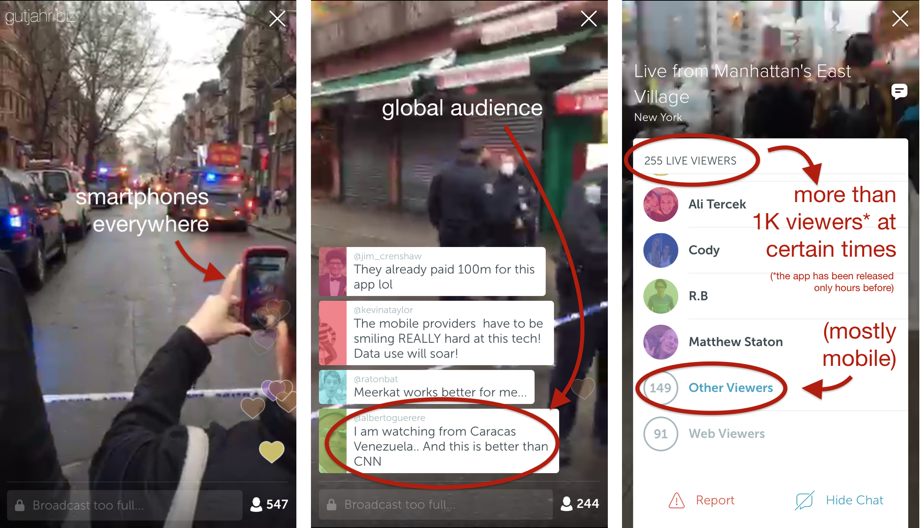
360-Journalism
Half an hour after the explosion the big news networks are still running breaking-news alerts. Maps are faded in, reporters are hooked up. Voice only. Over the telephone. By that time I can select from about a dozen video livestreams – directly from the site of the accident.
That is the more significant considering that the livestreaming app has only been available for a few hours in the app store. How many livestreams will there be from such a site a week, a month from now?
Dan Gillmor, Arizona State University journalism professor and author of a book about citizen journalism:
“When something newsworthy is happening where it is unexpected, the odds that a professional journalist holding a camera or video camera are small. But the odds that a regular person will be there are close to 100 percent.” (Japan Times)

Smartphone beats OB Van
So it can’t come as a surprise that the best reporting on that day was not from a traditional broadcast network. Not even from an experienced TV reporter. It came from a committed lady at Mashable, a tech-oriented news website, which is celebrating its tenth anniversary this year.
The reporter is not satisfied with just one live stream on that day. Because Periscope is still new and quite a few Mashable readers have only just gotten used to the idea of Meerkat, she manages to walk around the streets of Manhattan with two (!) iPhones 6 Plus (!!) in her hands and make live comments on what she sees.
And guess what: It works!
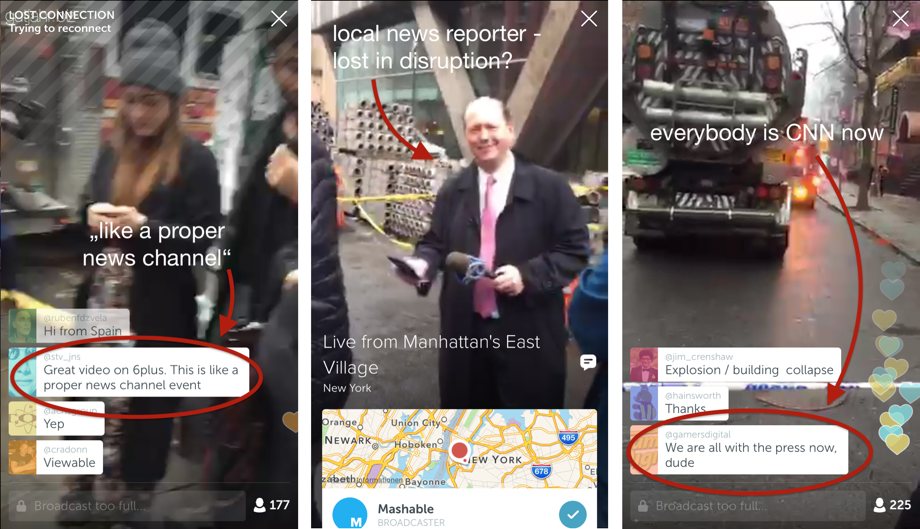
TV Reporters as Staffage
Compared to traditional television, where a reporter quite often arrives late at the scene and has to perform without any prior research, Smartphone livestreams come across as wonderfully factual and un-sensational.
I can even remember TV reporters who had agency material faxed to them from headquarters because they couldn’t do their own research – and they were on site! The result is a classic:
“I am standing here 500 meters away from the accident site. Behind me you can see that nothing can be seen.”
Journalism as a Computer Game
While TV Reporters are tied to their OB vans, and can only distance themselves a few meters away from them, the Mashable reporter could run free. This subjective camera perspective gives me the feeling at times as if I were running with her through the streets of Manhattan, almost like in a computer game.
I am mesmerized by knowing that the buildings, the fire engines and the sirens are real, and all this is happening in real time.
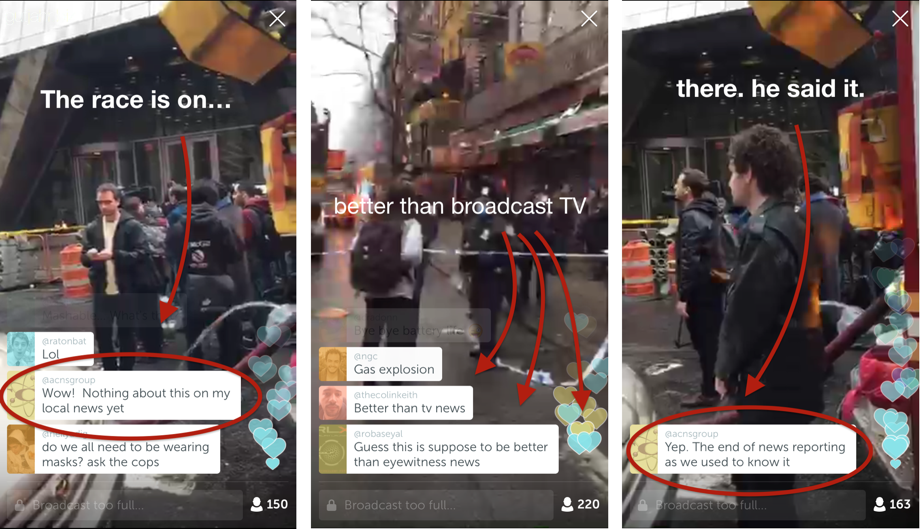
Journalism at its best
While I’m walking through the streets with the reporter, I learn a lot about the situation there. Unlike the sensationalists from CNN or Fox News this colleague manages to describe what she sees beyond the images – matter-of-factly and without sensationalism. She explains where she is exactly located and she gives background information about the East Village.
She describes the acrid smell in the air. She talks to cops and she interviews eye witnesses. I can even ask her questions via the chat function. The reporter literally lends me her eyes and ears. Journalism at its best!
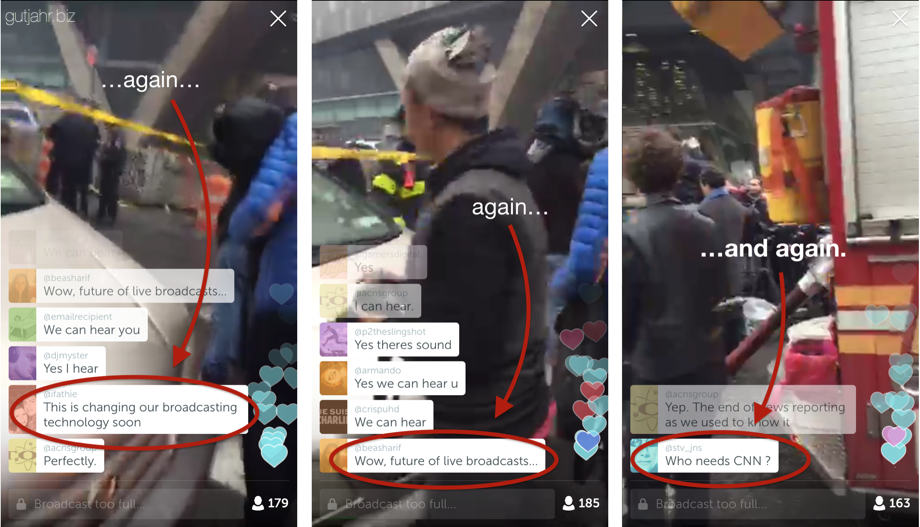
Everyone is CNN
And by this time I can imagine how many a fellow journalist will no longer be able to control his rage:
“And that’s what you call journalism?! That means from now on anyone could just grab a smartphone and call it journalism!”
Exactly. This colleague would have pinpointed our dilemma. Not only has new technology enabled anyone with a smartphone to become a reporter – sometimes these amateurs are even better at it than those colleagues who never question themselves or their own work and prefer to get lost in their hubris about quality journalism.
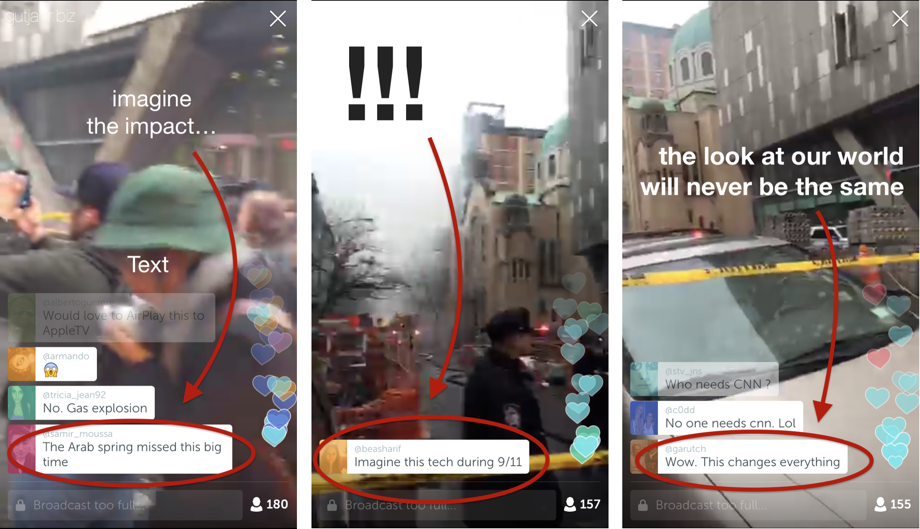
Livestream is the new Mainstream
I’m not saying that everyone was born to be a live reporter. But among millions of smartphone users all over the world, a few people who do a good job will suffice. Because there will be such an abundance of different streams images and information can be verified or debunked quickly, so that an accidental collaboration between a few amateur reporters will lead to a good overall impression.
I don’t want to deny that amateurs’ live streams can be prone to mishaps, hysteria or even misinformation. But if I look at the journalistic and ethical blunders we all had to endure in the reporting about last week’s plane crash, I don’t think professional journalists are in a position to act as if anything they do is up to their own standards.
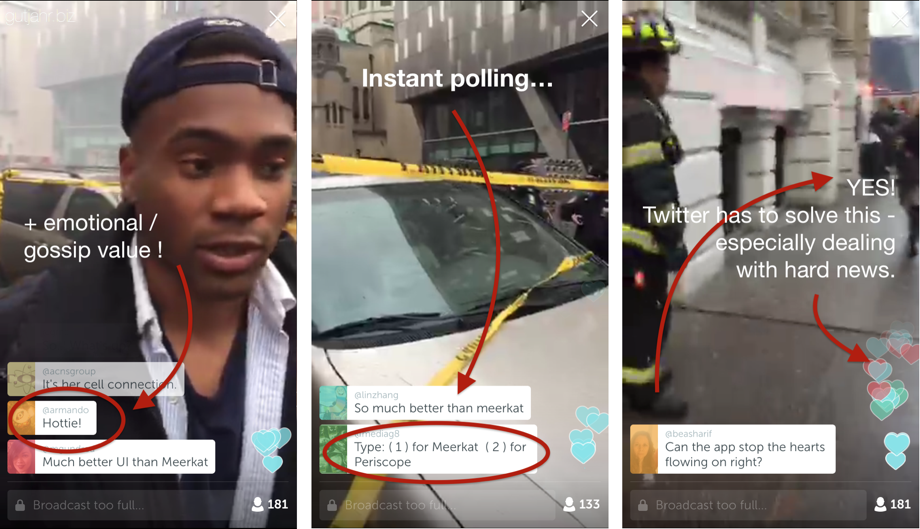
What we can Do
Instead of demonizing new apps such as Meerkat or Periscope journalists should make the effort to investigate what we can learn from a case study such as the gas explosion in New York. I made a few screenshots showing certain moments, as well as viewer comments that in my view demonstrate very well the strengths and weaknesses of this new media reality:
- Smartphones are omni-present
- The whole world is our audience
- Most livestream viewers watch on their mobile devices
- Video streaming over mobile networks consumes data like crazy – contracts will have to be adjusted
- Reporters shouldn’t leave home without extra battery packs
- By 2020 5G-networks will stream data faster than today’s fiberglas
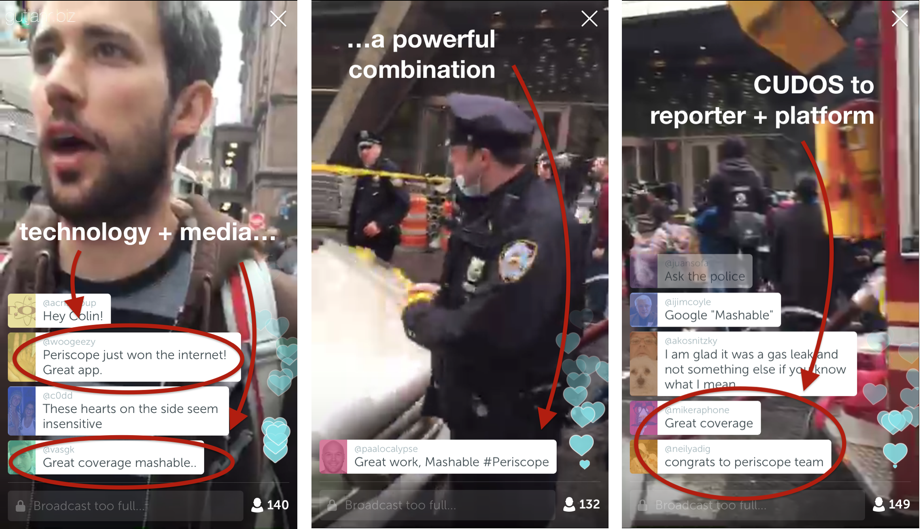
Both a Reporter’s performance and his Platform are Key
Here are my two most important insights from the Mashable reporting:
The journalist and his platform become a team. The audience will appreciate both the reporter’s contribution and the technology of the platform. Another indicator for how humans and technology are converging.
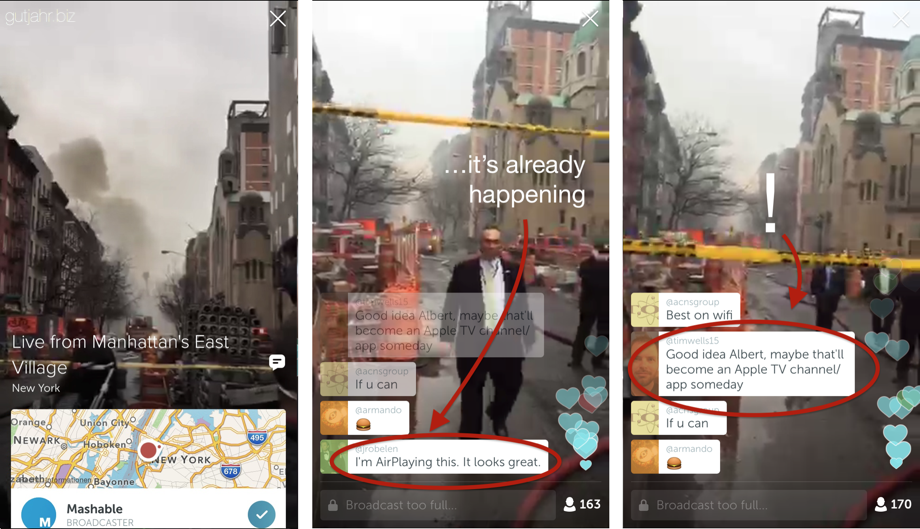
Attacking the Big Screen
As of now Meerkat and Periscope Livestreams are mainly watched on PCs, laptops or mobile devices. But what would happen if the “Big Four” (Apple Google, Facebook and Amazon) were to bring these livestreams to the big screens via their TV Boxes – right next to the regular networks? It can already be done via Airplay and it looks quite impressive (if you ignore the vertical smartphone format that is).
So we don’t need too much imagination to think of what this might look like in five years’ time. Are we ready for it?
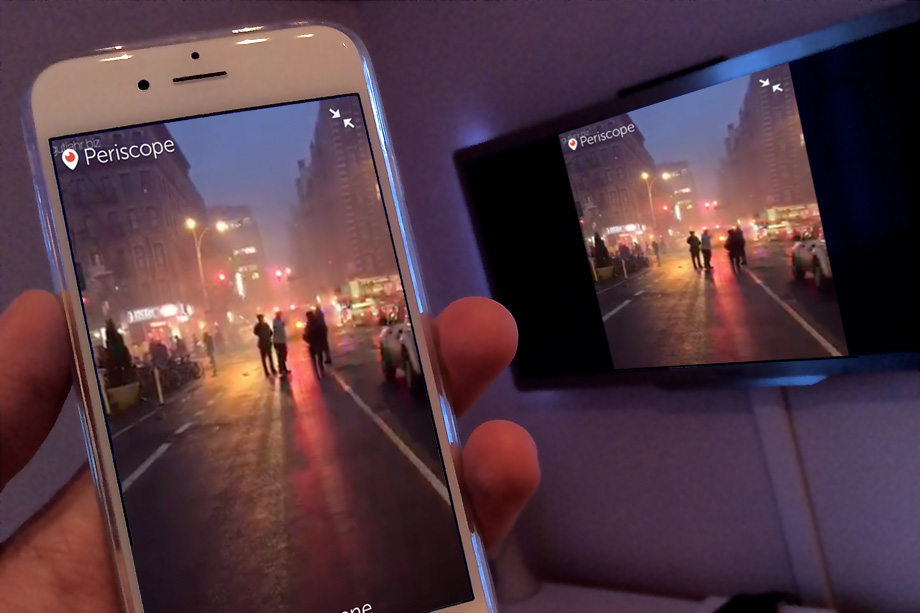
 Discussion
Discussion
What were your first impressions of Periscope or Meerkat? What are the advantages/disadvantages you see for journalists? How should we integrate these technologies into our work? Let me know! Talk to me!

[…] More: Livestream is the new Mainstream […]
[…] Abstand noch einmal betrachtet und eingeordnet zu werden. Im März 2015 bloggte ich über die neuen Livestreaming-Apps Meerkat und Periscope (vor allem mein englischer Text über Periscope erfreute sich an der US-Westküste offenbar großer […]